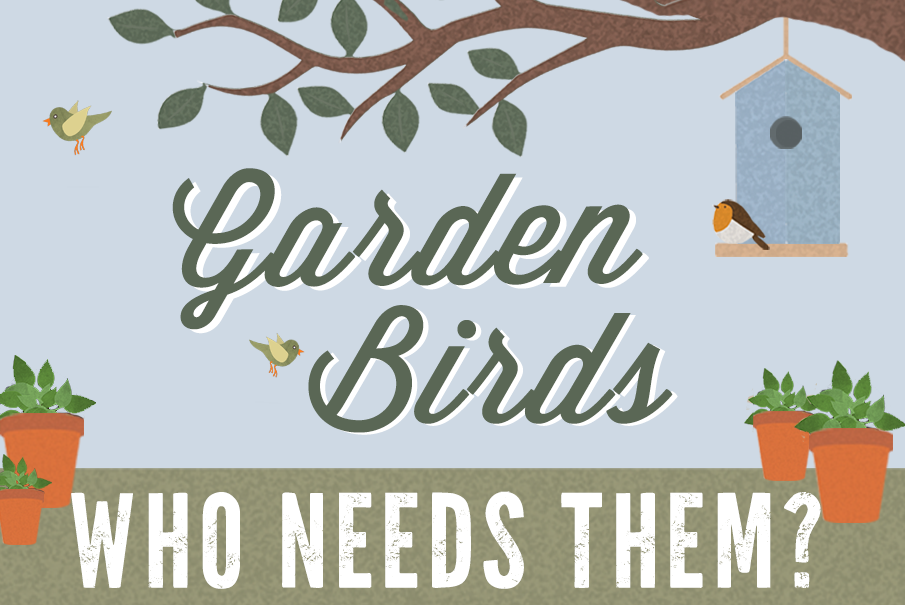Garden Birds - Who Needs Them?

As one of the best forms of natural pest control, garden birds can also help with cross pollination, weed control and enhancing biodiversity.
Increasing biodiversity in your garden and local area can quash the need for sprays and pesticides, many of which are harmful to the microbial life within the soil, and the environment.
Care UK reports that watching garden birds can help to improve concentration and memory, and relieve symptoms of anxiety, but few of us realise the impact they have on our greenspaces.
Encouraging smaller birds by offering supplementary food, clean water and shelter will encourage birds not only to visit your garden, but to return year after year. And who wouldn’t want that?
In this blog, we explain the best kinds of garden birds to attract, and how to deter their irksome friends: seagulls, pigeons and crows.
Top of the Pecking Order
Blue tits

Blue tits, with their striking blue crowns, are popular garden visitors due to their sweet song, and love for insects. They love crushed peanuts and mixed seeds, dried mealworms and live insects such as caterpillars, insects and larvae. Much like insects, blue tits are attracted to bushes and shrubs with colourful flowers and berries as they offer a safe spot to perch, away from predators. Rose bushes and clematis are particularly popular with these sweet songbirds.
Blue tit chicks need to eat around 100 caterpillars every day - so they’re a fantastic helping hand in managing numbers of caterpillars feeding on young plants.
Much like other garden birds, blue tits eat seeds and deposit them elsewhere, contributing to biodiversity in your garden and local area.
Dunnocks

About the same size as a robin, dunnocks can often be seen hopping around under hedgerows and on lawns. They’re mostly found in woodlands and parks where they nest and raise their young.
Dunnocks keep weeds at bay by eating seeds as they’re deposited onto the soil.
Stopping weeds before they get a chance to grow reduces the need for spraying chemicals on your plants, and polluting the soil. Dunnocks can be spotted searching for seeds in flower beds and on the lawn, picking the seeds up before they can germinate.
Wrens

The tiny wren is a firm favourite among gardeners and bird watchers alike. Weighing only 10 grams, the petite wren is surprisingly noisy.
Wrens are ground feeders and manage populations of pests, including caterpillars, larvae and beetles, as well as ants, slugs and snails.
Though they are small, their impact is mighty - roughly 95% of their diet consists of insects. Wrens can feed their young upwards of 100 insects each day.
Starlings

Perhaps most famous for their impressive murmurations, starlings are one of the most common birds found in the UK. However, starling numbers have declined more than 66% since the 1970s. This is likely due to a lack of food and nesting habitats.
Starlings feed on leatherjackets; the larvae of crane flies.
Crane flies - or daddy long legs - lay their eggs in the damp grass. When they hatch, the flies eat plant roots and can damage crops. Pesticides sprayed on lawns to kill the crane flies can, in turn, poison the birds that feed on them.
Starlings also eat gypsy moths and caterpillars, both of which are known to feed on crops, trees, fruit trees and shrubs.
How to Stop Fowl Play
Although these sweet birds are welcome visitors, other species of birds are certainly not. Seagulls, pigeons and crows are among the most mischievous garden pests. Shredded cauliflowers and decimated brussels sprouts all point to these larger garden birds.
So how can you ensure these birds take to the skies, whilst still encouraging helpful smaller birds?
- Netting is one of the best ways to ensure your vulnerable plants are safe from pests. Netting can be used to cover fruit cages, raised beds, fruit trees and ponds.
- Cloche tunnels and covers also work well for isolated plants and beds you need more regular access to. Cloches give instant protection to plants, and can be moved around the garden as needed.
Becoming Lord of the Wings
Encouraging a range of different birds into your garden will help improve the overall biodiversity, creating a harmonious ecosystem where pests are kept under control by their feathered predators, and plants are able to grow and thrive.
Did you like this blog? Why not read 10 Ways to Stop Slugs Eating Your Plants.
My cat is an active mouser, and was happily playing with his recent catch when he was mugged by a crow in the garden. It swooped down, scared him off and flew away with the catch. They’re not just a nuisance to plants!
Yes.Blue tits are pretty..and useful…but they also like eating the buds of my shrubs… I wish I could get more starlings..I got plenty leather jackets..they keep killing my primroses….